Importance of SEO Tools
An SEO tool is an application, that evaluates website results, and determines how it ranks in the SERPs. Such a tool helps websites to find new ranking opportunities.
With the help of an SEO tool, any website owner or SEO agency can easily locate and fix problematic sectors on a website, making their work more efficient. While aiming for concrete rankings in the SERPs, SEO tools can identify massive amounts of potential keywords.
While most people rely on manual work, an SEO assistant can easily boost productivity and help you discover new ranking possibilities, with minimum research, and smaller costs.
Hiring assistants for initial research is a good strategy, however, an SEO tool can do the same work twice faster, and lower expenses, which means you can invest more money into paid advertising, content, etc.
Benefits of SEO tools for your Website
Each SEO tool offers you a wide variety of suggestions and useful tips. By performing audits, SEO tools analyze errors on websites and outline problematic spots.
Fixing these issues can help website owners tremendously improve their websites, and have a better user experience.
For example, Ubersuggest is a great tool for auditing websites, and can easily help in finding problematic sectors.
Once those problematic sectors are eliminated, we can easily unleash the full potential of SEO tools, and use them to rank our small business higher.
1. Analyze keyword gaps for higher ranking
Why search for keywords, and try to figure out what people search for when you can spy on competitors?
Take the URLs of your competitors, input them in your SEO tool, and run a keyword gap analysis. Once the report has finished, you will be able to see what keywords competitors rank for.
This way, you can easily make your keywords list, use a content analyzing tool, and start outranking competitors in a matter of time.

However, if you are unsure who your competitors are, take the main keywords you want to rank for and perform a search.
Search engines will display the top 10 results, mixed with some ads. Scroll past any advertisement, and check for organically ranked websites.
Prepare a list of all competitors, and start analyzing them with your SEO tool, to gain knowledge on what they are ranking.
2. Search for fast-ranking keyword opportunities
With SEO tools, you can easily search for head terms, and receive hundreds of suggestions, accompanied by searches per month, cost-per-click price, and difficulty.
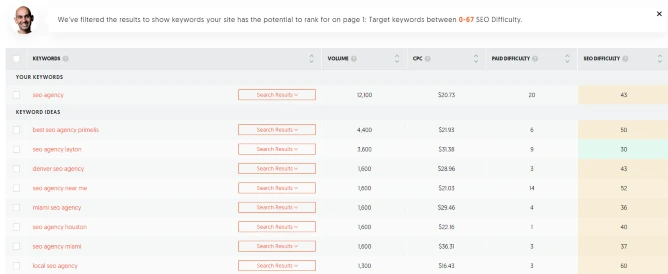
Searches per month can sometimes be inaccurate due to many reasons. First of all SEO tools cannot predict the exact searchability of a keyword.
Depending on the season some keywords start trending and later plummet, which is normal for these kinds of terms.
Trends can also bring higher searchability, but a trend is an unexpected occurrence, that cannot be predicted.
Last but not least, SEO tools can only provide an estimate of how much a keyword is searched.
With that said, even low-volume search terms can be more rewarding, so passing on such keywords can be a lost opportunity for the growth of your business.
3. Spy on competitors’ backlinks
Some websites are getting backlinks by registering an account, searching for broken links, or even guest posting. The truth is that it doesn’t take long for them to find good links for their websites.
What every competitor does is a simple backlink analysis of their competitors, making their work faster and more successful.
To perform backlink analysis, you can use a tool like Ubersuggest, and visit the backlink opportunity tab.
Place your domain in the first spot and up to 4 competitors in the field below. Ubersuggest will analyze and provide a list of domains, which are pointing to competitors but not to you.
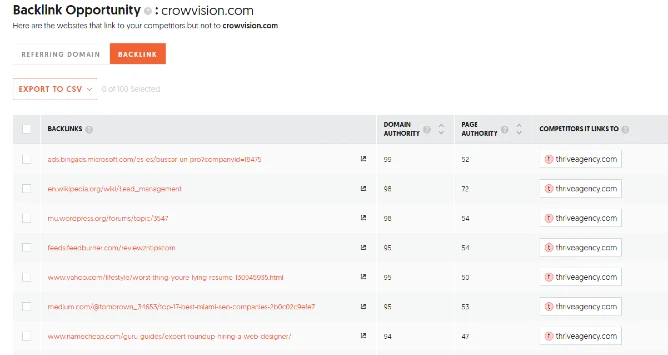
There are many backlink strategies, which are still effective and can produce hundreds of links per month, with little to no effort.
4. Find keyword opportunities
Find thousands of keywords, that are receiving millions of visitors and filter out the higher ones to rank for, so you can have an easy start and a winning website.
SEO tools allow searching for related keywords, which are known semantic keywords.
By including semantic keywords inside articles, a website will have more terms to rank for and lower the chances of using repetitive sentences.
They also give chances to rank better for similar terms and attract more visitors to your website.
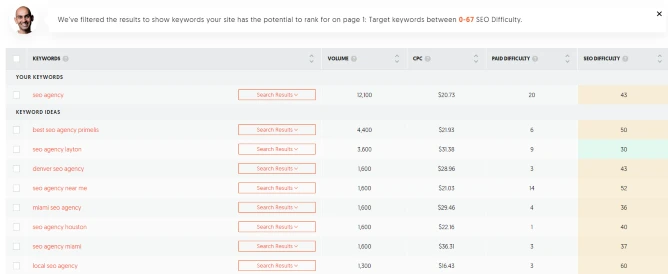
For example, the free version of Ubersuggest can prepare a large list of similar keywords, with their respectable SEO, and paid difficulty, helping a site owner to prepare a silo for the desired topic.
5. Track your top keywords
Tracking top keywords is a great opportunity to view how your website performs in the SERPs. Tracking keywords often happens by extracting a keyword list from Google Search Console and inputting it into your SEO tool.
After the keyword list has been successfully uploaded, keywords will be displayed in a small list, with their respective rankings.
While some people find it unnecessary, inserting keyword lists in SEO tools can be helpful for beginners, because they simplify the data gathered from Google Search Console.
If you try checking your rankings for a certain keyword in GSC, you will see floating rankings, or the need to choose a certain date for previewing the exact ranking, while SEO tools can track them day by day, and give you the results.
Aside from SEO tools, there are also stand-alone solutions, such as web analysis tools, which are cheaper and can be used for tracking keywords, and website performance.
6 . Spy on competitors and analyze gaps
Starting a new website can be a tough task when there is no ground covered, or strategy developed. A good way to start climbing rankings is to know, which topic should be covered first, and what is the difficulty of this topic.
As per Google’s new ranking factors, a website is required to have expertise in the field, authority, and trustworthiness to achieve good ranking spots.
Simply shooting articles with the idea to rank them is not beneficial anymore, as Google announced it will not provide them with any weight, no matter how good they are written.
However, structuring your content can easily provide better results, and build authority around your website.
By checking what competitors are ranking for, you can easily get an idea, of which articles should be written first, and create your topic cluster.
These topic clusters will act as the pillars of your website, with an opportunity to attract more backlinks, that pass link juice to other articles linked within your pillar content.
7. Improve existing content by outlining SEO mistakes
With an SEO tool, you can easily perform multiple website audits, and receive hundreds of suggestions, on how your content could be made better.
Whether you have an underperforming blog post or overoptimized content, an SEO tool will always find these problematic sectors and provide you with simple solutions.
The auditing process is not rocket science and can be done manually, however, these tools can speed up your work process and outline sectors, which require immediate actions.

Most of the time these mistakes could look like small and unrelated things, but removing them could ensure a large boost in your overall SEO strategy.
These errors could be smaller titles, blocked pages, missing H1 tags, lower word counts, missing meta descriptions, and much more.
An SEO tool can also provide you with recommendations on how your content could be edited, followed by outlining your content’s headings.
8. Provide new and existing content suggestions
One of the easiest ways to create a content silo is through content suggestions from SEO tools. After a website audit, the SEO tool will understand your content, and seek opportunities to rank it higher.
A tool like Ubersuggest can easily research an article piece, and deliver small improvements in the form of suggestions for ranking purposes.
It could be including certain keywords for better SERP placement, or creating a new content piece around a certain topic, which will later be linked to the original article.
These suggestions come in handy in times when siloing seems hard, by lowering the research times and improving the time to write your content piece.
9. Analyze backlink opportunities
Cold outreach is a dead strategy nowadays. Sending hundreds of emails will result in less than 2% of answers and 1% acceptance rates.
Not to mention how much time it takes to research websites and their business email addresses.
A better way to acquire backlinks aside from building long-form content is from backlink analyzing features, inside of SEO tools.
In Ubersuggest, website owners can perform an audit on their competitors, and see what links are pointing to competitor sites, but not their own.
Using such features could boost time spent on research, and make your backlink-acquiring strategy more efficient.
Since other sites are linking to your competitors, the chances of them sending you a link are higher. Especially when the competitor’s content is outdated.
10. Track and remove toxic domains
Since Google has developed a new algorithm for determining spammy links that will degrade their results, many site owners are exposed to serious damage.
Getting spammed with low-quality links, and PBNs can result in serious penalties for site owners, for potential manipulation of the SERPs results.
Another problematic thing could be image links, which nowadays are a great way of hijacking link juice. Competitors often send hundreds of spammy image links to websites with the sole purpose of destroying their websites and getting them punished for manipulation.
However, SEO tools provide their special backlink analyzing features, which show who is currently linking to a website, and what spam score this website has.
A tool like Semrush categorizes all links and can provide a full list of toxic domains. These domains can be marked, and input into a domain disavowing list, which is used to drop the links, pointing to a website.
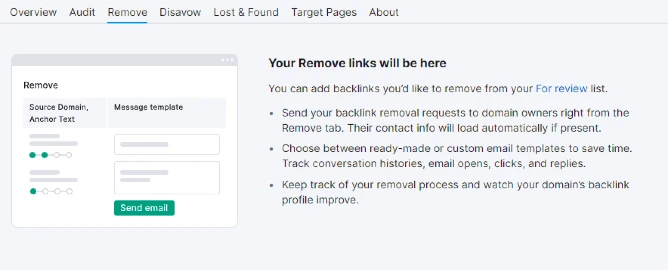
Google periodically updates its disavow lists, but the time it could take is ranging from 8 to 12 weeks.
11. Can help local businesses rank for local keywords
For a local business, targeting locally searched terms is of crucial importance. Depending on the country, local areas have different ways of typing what they need in the search.
Knowing their search intention is also hidden when checking the SERPs, however, an SEO tool will try to gather similar search results. These search terms can be area-specific (optional when using SEO tools), and give you a large list of keywords, that local searchers use to find information or buy a product.
Locally searched keywords provided by SEO tools come with their respective traffic estimates and cost-per-click prices.
While they do not provide the overall results but pull data from Google Ads, and other integration tools, the data could be used to benefit any local business and boost their overall results.
12. SEO tools can be used for free
Aside from paying monthly subscriptions, you can use SEO tools for free. Each of your favorite SEO analyzers has a free version with certain features, which can be used daily.
Even the most popular plugin Ahrefs has its free version, where keyword research and website audits are provided to you for free.
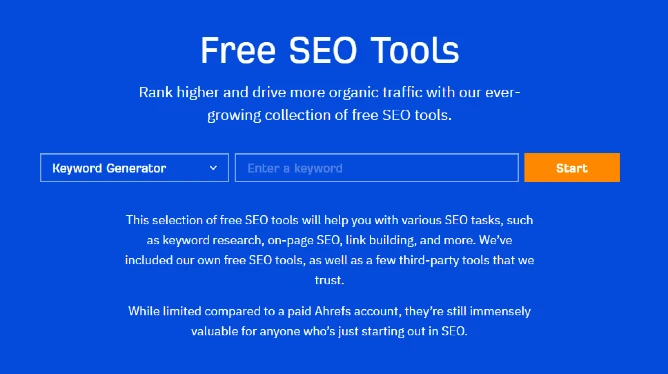
For example, Ahrefs has provided website owners with the option to audit verified through GSC websites and receive a full list of their website’s performance.
Each time the website needs to be crawled, Ahrefs will deduce a certain amount of credits (depending on the pages crawled), and prepare the audit, outlining all red sectors, and warnings, and giving hints on what should be fixed.
On top of that, Ahrefs and other SEO tools, provide a free keyword research tool, which can be used a couple of times per day, and help you make large keyword lists for each topic, that needs to be covered.
Conclusion
Using SEO tools for your website can be a huge boost for both small and large websites. Such tools allow you to create powerful SEO strategies by spying on competitors, conducting keyword research, and much more.
However, nobody should blindly follow everything that an SEO tool suggests. At the end of the day, they provide estimates and not real-world data.
Mixing them up with our local SEO tips, and some manual work can be a perfect way, as their main purpose is to help with your research and provide results.
The content writing and clustering parts can be done with the help of content writing tools, but don’t get too obsessed with AI. Conducting your research sometimes proves to be a better way to score in the SERPs.
